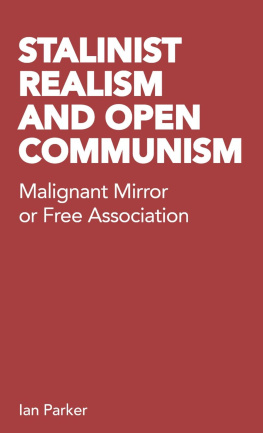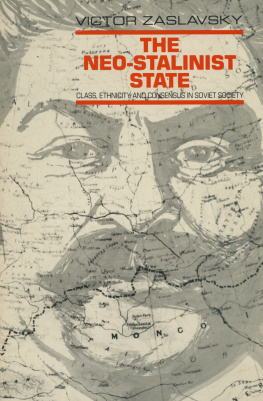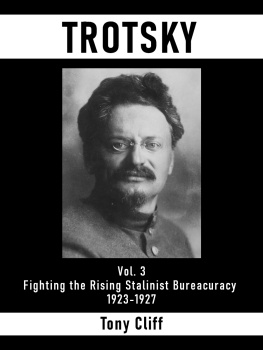About the Author
Keith A. Livers is Assistant Professor at the University of Texas at Austin, where he teaches Russian literature, culture, and language. His research and publishing concerns twentieth-century Russian literature and film, with a strong emphasis on authors of the Stalinist and post-Soviet periods. He holds a Ph.D. from the University of Michigan.
Acknowledgments
I would like to express my thanks to the following people for the help, understanding, and patience that they showed during my researching and writing of this book. First of all, I owe a great debt of gratitude to Sydney Monas for his careful reading not only of this manuscript but of everything else I have written while at the University of Texas. His many insights, commentary, and enthusiasm were an essential part of this project and were a genuine inspiration to me throughout the process. I would also like to thank Hana Pichova, Joan Neuberger, and Lida Oukaderova for their patient reading and rereading of the manuscript. I am grateful to Hana not only for her friendship and support, but for the wealth of practical advice and guidance she has given me over the years. I am also indebted to Joan Neuberger for her advice on this project and her help on matters relating to Russian cinema. My friendship with Lidaparticularly our many spirited conversations about Russian literature and culturehave enriched me in too many ways to enumerate. I would like to thank the office staff in the Department of Slavic Languages at the University of Texas. Finally, gratitude and much love to my very good friend Stacey Thompson, who helped me make it through many of the more trying moments of book writing.
Conclusion
Stalinist Bodies on Display
In his 1994 novel The Life of Insects Viktor Pelevin deftly compares a group of furiously dancing post-Soviet youth, who in their own way are searching for the deeper meaning of life, to a dump where plaster statues gathered from Parks of Culture and Rest throughout the country are unceremiously abandoned. The flashing strobe light mounted above the dance floor creates the eeriest of impressions. The gyrating dancers (who like all the characters in the novel are actually insects) are transformed into a series of freeze frames, each of which resembles a different Park of Culture and Rest adorned with an identical complement of lifeless statuary. Published only several years after the breakup of the Soviet Union, Pelevins novel portrays the countrys quest for a new identity against the backdrop of suddenly fallen idols and discarded myths. That Pelevin should use this rather macabre fusing of bodies and superannuated statues to symbolize the state of contemporary society is puzzling only to the non-Russian reader. For it evokes in terms instantly recognizable to almost any inhabitant of the former Soviet Union the extreme fragmentation of the post-Soviet body politic by symbolically deconstructing one of its most cherished and commonplace icons: the Stalin-era statue.
Indeed, even a cursory glance at the cultural landscape of the Stalinist period reveals the eras uncommon fascination with statuary and sculpture of various kinds. The Soviet pavilion of the 1939 Worlds Fair in New York, designed by Iofan and meant to reflect the as yet unconstructed Palace of Soviets, was no exception. Distinguished not only by the remarkable speed with which it was assembled, the pavilion was embellished with a wealth of statuary. The wings of the building portrayed the twin faces of Stalinist heroism, with one side devoted to the civil war and the other to industrialization. Most importantly, the pavilion was topped by a giant statuemeasuring 24 meters in height and weighing 30 tonsof a worker holding up a red star.1 And finally the Palace of Soviets itself, which when built, would be the highest building on earth, higher than the Great Pyramid of Cheops, higher than Cologne Cathedral or the Eiffel Tower, taller than the highest skyscraper in New York, was to be surmounted by a statue of Lenin, measuring 328 feet.2 As Zolotonosov points out, sculpture was without a doubt one of the dominant (if not the dominant) culture code of the Stalinist period.3 Whether in the newly constructed metro or in the numerous Parks of Culture and Rest, such sculpted bodies provided a statuary microcosm of Stalinist society. Every aspect of official ideology and mythology could, in a sense, be gleaned from this broad array of embodied postures and gestures, gestures which represented such all-important Stalinist mythologemes as the leader, childhood, the mother, and so on.4 More importantly, since the overarching metaphor of social cohesion was that of the social or collective body, these sculptures ultimately served as the most concise expression of what the society as a whole was endeavoring to produce. One might say, in other words, that in the image of the statue lay the keys to a new kind of uniquely Stalinist subjectivity. And from here it is no stretch to see such bodies as endowed with a distinct and even powerful erotic appeal.5 Thus in a contemporary short story by Yuri Buida, a tippling Dostoevsky enthusiast who works as a watchman at a Park of Culture and Rest finds love and ultimately death in the arms of the famous Girl with an Oar who has miraculously come to life.6
If the Stalinist statue-body was representative of a world in which the dream of communism had been neatly reproduced in plaster and stone, the actual bodies of living human beings were quite another matter. Here the struggle to realize the ideal of utopia found was complicated by the retrograde character of the material to be transformed: i.e., human psychophysiology. This is powerfully expressed in Platonovs most important work of fiction from the 1930sthe unfinished novel Happy Moscow. In it the author repeatedly suggests that the historical novelty of communist ideology must be weighed against the eternal recalcitrance of (human) naturean unequal contest if ever there was one! And in a key episode of the novel Platonov juxtaposes the linear narrative of Stalinist ideology (on the streets and squares a modest Stalin watched over all the open roads,... life stretched into... the distance from which there was no return) with the eternal round of human existence. Thus at the Krestovskii market one finds coats that during the revolution had passed through so many hands that the circumference/meridian of the earths sphere was too small to measure their path between... humans.7 The very curve of the earths surface, the author hints, suggests a model of human history as eternal return that belies the revolutions facile pathos of futuricity.
Despite the considerable challenges involved in Stalinisms revolutionary project, there seems to have been no shortage of Soviet citizens willing to participate in what amounted to a collective ritual of psychophysiological reconstruction. This is hardly surprising, since the latter were simply internalizing or realizing the metaphors that governed vast, highly visible swaths of public discourse. And unlike the perennially pessimistic hero of Platonovs 1929 novella The Foundation Pit who muses that a man will make a building and unmake himself,8 many Stalin-era subjects understood only too well the connection between the forging of iron and steel and the forging of the self. Among a host of such projects, the Moscow metro stands out as one of the most memorable. As with other similar undertakings, the construction site of the first-ever socialist metro served the dual purpose of taming the benighted underworld even as it transformed backward (human) elements into model worker-citizens. Thus in one account we are told that the construction of the Moscow subway is like a gigantic human machine, which in addition to material values produces yet another value that lies in the transformation of human beings.9 This was to be true not only for the builders of the metro, but for those who would one day travel through the bowels of a reclaimed underground. The formeroften unskilled laborers or recent arrivals from the countrywould typically be potrayed as having acquired several specializations while working underground, at the same time that they raised their educational level by participating in various organized cultural activities.10 As to how the metro might change the human countenance of its passengers, one could only speculateand some writers did. The prominent satirical duo of Ilf and Petrov described the subway as the antidote par excellence to the chaotic, overcrowded crucibles of





